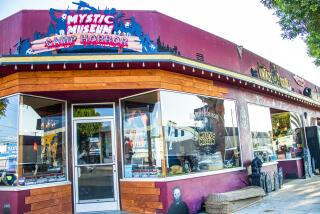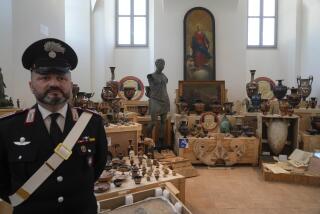Police Query Getty Museum on Statue Italians Believe Was Smuggled Out
- Share via
A Los Angeles police investigator met at length Wednesday with officials of the J. Paul Getty Museum, exploring the museum’s acquisition of an artistically important antiquity that Italian officials now claim might have been smuggled off Sicily.
Detective William Martin said that in a two-hour session Getty officials produced “everything I asked for,” including documents detailing the museum’s purchase of the piece in question, a limestone-and-marble statue believed to date from 420 BC.
Martin declined to divulge details of his discussion or the documents, saying only: “The Getty was completely candid, open and they hid nothing from me as far as I can tell. . . . There is no evidence of any criminal activity on the Getty’s part.”
The LAPD detective, an art fraud expert, pursued his inquiry at the request of Interpol. He said his findings would be forwarded today to Italian police who, for the last month, have been pursuing the possibility that the statue was taken illegally from an archeological dig nearly a decade ago and then placed in circulation on Europe’s black market in antiquities.
U.S. Customs officials, meanwhile, said that a value of $20 million was declared for the large statue when it passed through customs Dec. 15, 1987, at Los Angeles International Airport. The Getty, citing internal policy, has refused to reveal the price, the seller or the recent history of the statue.
The Getty apparently purchased the piece from a London trader acting on behalf of an as-yet-unnamed European client. The transaction was completed last July after months of intense expert inspection into its validity and artistic worth. The statue is believed to have been sculpted during the Greek colonization of Sicily and is said to represent a Greek goddess. It was unveiled only last Thursday, stirring a chorus of praise about its cultural importance from art critics around the world.
On the heels of acclaim, however, came controversy. Italian police and government officials charged with stemming a hemorrhage of art out of the country subsequently told reporters that in the late 1970s a statue was rumored to have been discovered and removed from a Sicilian archeological dig at Morgantina by smugglers. Such plundering is not uncommon.
The Italian authorities, whose inquiry to this point appears grounded more in art history and rumor rather than forensics, want to know if the Getty piece is that statue--and, if so, how it eventually made its way into the museum’s possession.
Italy’s Ministry of Culture issued a statement Wednesday that declared: “If the statue of Aphrodite in the Getty Museum is authentic and came from Italy, it was never exported legally.”
That the statue at some time was removed from the country illegally would not alone be sufficient grounds to pry it from the Getty. Purchases of antiquities are governed by international regulations intended to prevent smugglers from putting new or stolen pieces on the black market, while allowing artwork already in circulation to be bought and sold.
Generally, museums must establish that a seller has clear title to a piece and that no formal claims of theft have been lodged by individuals or the likely countries of origin. If pre-purchase investigations fail to turn up such claims, museums can then complete their transactions.
The museum, in a statement of its own Wednesday, reiterated that it had made numerous unsuccessful attempts before the purchase to determine if the piece had been reported stolen, or if any country objected to the acquisition. There were no such claims, the museum said.
The museum stated that a Mailgram from the art superintendent who oversees the Morgantina site, alerting the Getty to the Italian police investigation, was not received until after the purchase contract was signed in late July. At that point, the museum chose not to put off its announcement of the acquisition.
“Our policy calls for us to announce and exhibit acquisitions promptly,” said John Walsh, the Getty director. “We put things on exhibition right away to be sure a piece is known, and if there are objections they will be made right away.”
In its statement, the museum said, “The allegations that have been reported about the history of the statue have not, to our knowledge, been substantiated by any evidence or established facts. They are purely speculative.”
Nonetheless, the Getty added that if “a valid legal claim to the statue is substantiated by Italy, the museum will return the statue.”
Compounding the situation is the Getty’s policy of not revealing price or seller of its acquisitions. The Metropolitan Museum of Art has a similar policy, according to Ashton Hawkins, executive vice president and counsel to the Met’s Board of Trustees. “We don’t really want people to know what we pay for things. It serves no interest. In fact it hurts us in terms of the marketplace if people know what we are paying and who we are buying from.”
The Los Angeles County Museum of Art has the same policy.
The Getty’s four-page statement also added an interesting new detail to the emerging chronology of the international art controversy. It noted that “the speculation that the statue might have been illegally removed from Morgantina, Sicily, was put to us recently by a reporter for the magazine Connoisseur.”
At that point, the museum contacted a U.S. professor at the archeological site, asking him to explore the possibility of smuggling. He went to the local government official in charge of art matters, who subsequently went to the Italian police--initiating the investigation that led to the visit Wednesday to the Getty by the LAPD’s Martin.
All of this adds to the intrigue because Connoisseur is edited by Thomas H. P. Hoving, a former director of the Metropolitan Museum of Art in New York. During his tenure at the New York museum, Hoving was embroiled in a public dispute with one of his curators, John Walsh, who has since come to Southern California as director of the Getty.
From his position as editor of the monthly arts magazine, Hoving has been a vigilant critic of the Getty and Walsh, and Connoisseur has been in the lead of a series of exposes about the museum. The long-running feud is a staple of art world gossip, and the possibility that Hoving’s hand played a role in the latest Getty controversy now abounds among art sources.
Hoving declined to discuss his role, if any, complaining Wednesday that the Los Angeles Times “tried to steal my story.” This was a reference to an account of the statue investigation delivered this week to a Times editor by a Paris-based free-lance writer who, in the past, has written for Connoisseur, as well as for The Times.
The article by Paul Chutkow said Connoisseur began investigating the acquisition last June and was making its “interim findings . . . available to The Times.” It disclosed the Italian police investigation and credited one of its correspondents with tipping Interpol to the case.
When editors at The Times assigned reporters to verify independently the facts in the story, delaying its publication, Hoving contacted the newspaper and complained.
“He wanted us to use Chutkow story pretty much as is,” said Robert Epstein, executive arts editor of The Times. “ . . . In effect, he said, ‘If you aren’t going to use the story than we withdraw our permission for you to use his story.’ ”
Chutkow’s account subsequently appeared Wednesday under his byline in the International Herald-Tribune.
More to Read
Sign up for Essential California
The most important California stories and recommendations in your inbox every morning.
You may occasionally receive promotional content from the Los Angeles Times.











